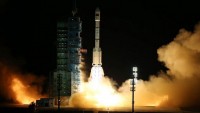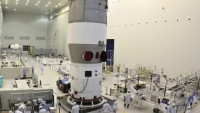China’s Shenzhou-11 Spacecraft Chasing Tiangong-2 Space Station
| Arthur Dominic Villasanta | | Oct 17, 2016 01:21 AM EDT |
(Photo : CCTV) Shenzhou 11 crew.
China's Shenzhou-11 spacecraft with two taikonauts aboard is currently chasing the Tiangong-2 space station after a successful launch from the Jiuquan Satellite Launch Center in the Gobi Desert at 7:30 p.m. EDT (GMT-4) on Oct. 17.
The spacecraft is expected to catch-up to the speeding Tiangong-2 on Tuesday. Its crew, mission commander Jing Haipeng and flight engineer Chen Dong, will maneuver Shenzhou-11 to a safe docking with the space station.
Like Us on Facebook
Once inside Tiangong-2, both men will begin an intense series of experiments for the next 30 days. The men will carry out materials science experiments; medical research; three student experiments; plant growth studies and test orbital repair techniques.
"After entering Tiangong-2, the taikonauts will carry out many experiments, which show the roles, effects and value of humans in many space activities," said Wu Ping, a spokeswoman for China's Manned Space Engineering Office.
Tiangong-2, originally built as a back-up to Tiangong-1, has a length of 14 meters and a diameter of 3.4 meters. It weighs 8,500 kilograms.
The new station has a larger payload capacity, allowing improved living conditions for its crew of three astronauts. The crew will be able to survive for 20 days without resupply.
"The astronauts can now have a better dining and sleeping environment in the spacelab, and they have also physical exercises for experiments and recreation facilities," said Wu.
"These changes will make the 30-day life for the astronaut in space more comfortable, convenient and more colorful."
Tiangong-2 will also be equipped with a new robotic arm. It's accompanied by a small Banxing-2 satellite for technology demonstrations.
Banxing-2 (the word means Companion Satellite) is a small technology development satellite that will capture images of the new station in orbit. Its predecessor, Banxing-1, accomplished the same mission for the Shenzhou 7 in September 2008.
In April 2017, China's first space cargo ship, Tianzhou-1 carrying fuel and other supplies, will dock with Tiangong-2. The astronauts at this time will carry out experiments related to aerospace medicine, space physics and biology, such as quantum key distribution, atomic space clocks and solar storm research.
They will also conduct a space-Earth quantum key distribution and a laser communications experiment to facilitate space-to-ground quantum communication.
Then there's POLAR, a collaboration between Swiss, Polish and Chinese institutions to study gamma ray bursts, which are the most energetic events in the universe.
At the end of their mission in November, Jing and Chen will undock and return to Earth in the Shenzhou spacecraft's central descent module and land in Inner Mongolia.
TagsShenzhou 11, Tiangong-2, Jing Haipeng, Chen Dong, Tianzhou-1
©2015 Chinatopix All rights reserved. Do not reproduce without permission
EDITOR'S PICKS
-

Did the Trump administration just announce plans for a trade war with ‘hostile’ China and Russia?
-

US Senate passes Taiwan travel bill slammed by China
-

As Yan Sihong’s family grieves, here are other Chinese students who went missing abroad. Some have never been found
-

Beijing blasts Western critics who ‘smear China’ with the term sharp power
-

China Envoy Seeks to Defuse Tensions With U.S. as a Trade War Brews
-

Singapore's Deputy PM Provides Bitcoin Vote of Confidence Amid China's Blanket Bans
-

China warns investors over risks in overseas virtual currency trading
-

Chinese government most trustworthy: survey
-

Kashima Antlers On Course For Back-To-Back Titles
MOST POPULAR
LATEST NEWS
Zhou Yongkang: China's Former Security Chief Sentenced to Life in Prison

China's former Chief of the Ministry of Public Security, Zhou Yongkang, has been given a life sentence after he was found guilty of abusing his office, bribery and deliberately ... Full Article
TRENDING STORY

China Pork Prices Expected to Stabilize As The Supplies Recover

Elephone P9000 Smartphone is now on Sale on Amazon India

There's a Big Chance Cliffhangers Won't Still Be Resolved When Grey's Anatomy Season 13 Returns

Supreme Court Ruled on Samsung vs Apple Dispute for Patent Infringement

Microsoft Surface Pro 5 Rumors and Release Date: What is the Latest?












